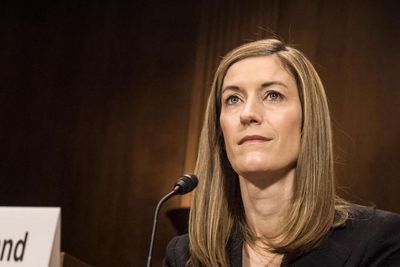
10 February 2018
TRENDING
Only weeks after Robert S. Mueller III was appointed to serve as special counsel overseeing the investigation into the Trump campaign's possible connections to Russian actors, rumors were rampant that President Trump wanted to bring the ax down. It's not easy for Trump to fire Mueller, as we noted at the time, since technically Mueller can only be fired by Deputy Attorney General Rod J. Rosenstein.
Why? Because Attorney General Jeff Sessions, who would normally oversee the special counsel, recused himself from campaign-related investigations given his proximity to Trump's electoral effort. If Trump wanted to fire Mueller, then, he needed to get Rosenstein to do it — or he needed to undertake a Richard Nixon-style purge of the Justice Department until he got to someone who would do the dirty work.
At the time, we made this chart, showing who was lined up behind Rosenstein and might be asked to step in if Rosenstein was fired.
Dana Boente was second in line — until he announced his plan to retire from the department last October. (He's now serving as general counsel at the FBI.) The chart got another change Friday, when the New York Times reported that Associate Attorney General Rachel Brand was planning to leave the department as well, less than a year after being elevated to the No. 3 position.
It would seem, then, that our chain of command looks like this.
But it doesn't.
Last June, the Trump administration was still slowly rolling out its nominees for empty positions in the Justice Department (and other places). Boente was fourth in line at the department because slots above and below him were vacant.
There are two documents that dictate the chain of command at the department. The first is a 2007 document, Attorney General Order No. 2877-2007, which establishes the next five positions to assume command of the department after the associate attorney general. The other document is an executive order signed by Trump last March that adds three U.S. attorneys at the end.
The full chain of command, then, looks like this:
• Sessions (ineligible; recused)
• Rosenstein
• Solicitor General Noel Francisco (confirmed in September)
• Assistant Attorney General in the Office of Legal Counsel Steven Engel (confirmed in September)
• U.S. Attorney for the Eastern District of North Carolina Robert Higdon Jr. (confirmed in September)
• U.S. Attorney for the Northern District of Texas Erin Nealy Cox (confirmed in November)
In between Engel and Higdon are a number of other positions currently filled by acting officials. That includes Edward O'Callaghan, the acting assistant attorney general for national security who took over for Boente. (John Demers was nominated last year to hold the position permanently.) There's also Jesse Panuccio, who will be the acting associate attorney general replacing Brand. Should any of those positions be confirmed, those individuals will slide into the chain of command.
So, if Trump wants to execute a Saturday Night Massacre of Mueller and Rosenstein demurs, it is Francisco who'd next be asked to carry out the task. In 1973, it was Nixon's solicitor general — future Supreme Court nominee Robert Bork — who fired Special Prosecutor Archibald Cox.
Of course, all of this may be unnecessary. Earlier this week, I spoke with Louis Seidman, Carmack Waterhouse professor of constitutional law at Georgetown University. He explained that he didn't think Trump was likely to fire Mueller. Instead, if he wanted to obstruct Mueller's investigation, he could probably fire Rosenstein and replace him with any other already-Senate-confirmed administration official under the Vacancies Reform Act of 1998. ("Probably," because it's not clear that this applies to someone who is fired.) If so, Trump could fire Rosenstein, make, say, Energy Secretary Rick Perry the deputy attorney general, and let Perry refuse to allow Mueller to file any more indictments or subpoenas.
Brand's resignation means that she no longer has to worry about getting a call from Trump ordering her to fire Mueller. Fox News reports that she is leaving to pursue a job in the private sector, but given the tension between the White House and its Justice Department at the moment, it is hard to believe that Brand will miss being so high up on that particular chain.
Philip Bump, Washington Post, February 9, 2018
###
February 10, 2018